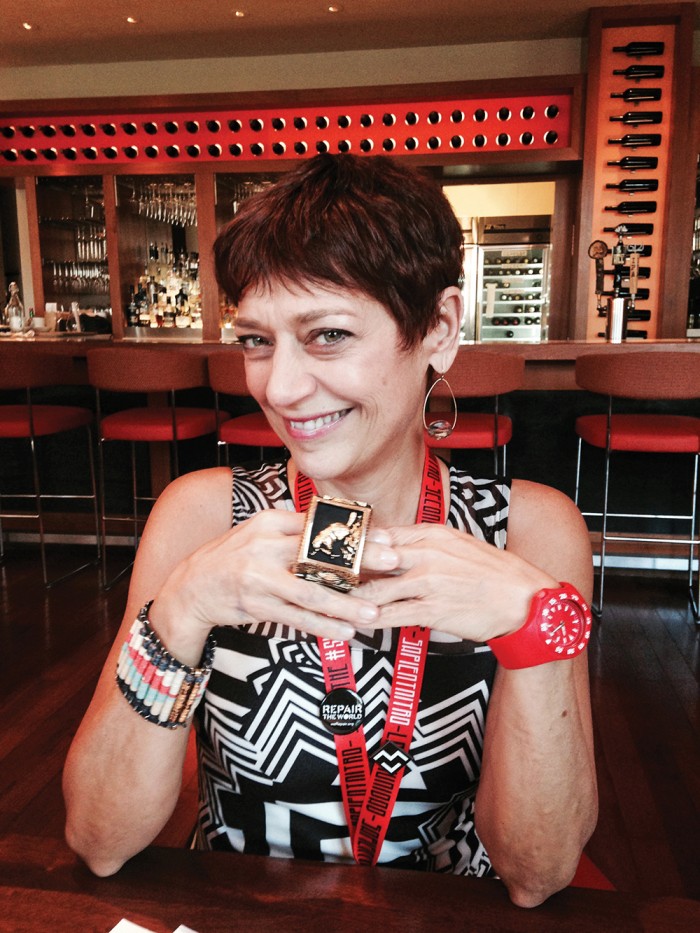The South by Southwest (SXSW) Interactive festival has been called the world’s largest incubator for emerging technologies. For a few days every March, tens of thousands of scientists, researchers, and entrepreneurs gather in classrooms, pubs, and conference halls in Austin to discuss topics like synthetic biology, Bitcoin, and digital storytelling.
If that scenario sounds similar to what goes on in Kendall Square, located 1,800 miles northeast of Texas, you’re right. So it’s no surprise that the MIT community has a huge, growing presence at the weeklong festival.
“MIT alumni are always involved in the cutting edge of technology, and that’s exactly what’s going on there,” says Catherine Havasi ’03, MEng ’04, CEO of Luminoso, a Media Lab spinout that uses natural language processing and machine learning to derive insights from text such as social media, consumer reviews, and news articles. “It’s always been a space where you can get feedback on your craziest ideas. That’s why we’re so attracted to it.”

SXSW Interactive is an offshoot of the larger SXSW festival, which started as a loose gathering of a few hundred Austin music fans in 1987. By 1994, when the festival featured a keynote performance by Johnny Cash, SXSW attendance had swelled to the thousands, and subject matter expanded to art and innovation. The Interactive festival was launched in 1995 (SXSW Film and SXSWedu would follow), and a few years later, USA Today would call SXSW “one of the largest and most influential gatherings on the planet.”
“The MIT perspective uses technology and engineering to solve the world’s pressing problems,” says Idit Harel, PhD ’88, who hosted the White House–sponsored Austin Education Game Jam at SXSW in 2015. “And the SXSW learning environment is an MIT-style, Media Lab–style learning environment.”
Nearly 150 MIT alumni—about 8 percent of all Interactive presenters—were featured in some 100 sessions at the Interactive festival, which included a keynote presentation from Jonah Peretti, SM ’01, the founder of BuzzFeed and the Huffington Post. And the multiday MIT Media Lab Lounge event, held in an Austin restaurant turned innovation space, hosted panel discussions and demos focused on synthetic biology.
“The theme of the conference really connects with the MIT psyche of the techie nerd,” says Bernat Olle, SM ’05, MBA ’07, PhD ’07, who discussed his research on the human microbiome at the 2015 festival. “You look around and think we could have something like this in Cambridge and it would fit right in.”
Indeed, the development of Hubweek, a festival celebrating innovation and creativity in Cambridge and Boston, was already well under way by SXSW 2015. Hubweek, cosponsored by MIT, the Boston Globe, Harvard University, and Mass. General Hospital and founded by chair Linda Pizzuti Henry, SM ’05, featured 106 events highlighting the impact of science and technology in society over eight days in Cambridge and Boston last October. MIT helped kick off Hubweek with the launch of Solve, a four-day gathering produced by MIT Technology Review that itself launched an ongoing program to bring together decision makers and activists to address world challenges.
Robert Metcalfe ’69, the co-inventor of the Ethernet, has seen the innovation engines of both Austin and Boston up close. “It’s clear the organizers of Hubweek looked to SXSW, and that’s a great thing,” says Metcalfe, the director of innovation at the University of Texas at Austin and a longtime participant at SXSW, who attended Hubweek and Solve. “MIT used Boston’s convening power to great effect—in some cases, the audience was as impressive as the speakers. The challenge ahead is making something meaningful happen as a result.”
MIT alumni who are attending SXSW or live in the Austin area are invited to a reception cohosted by MIT Technology Review and the MIT Alumni Association on Friday, March 11, from 7:30 to 11:00 p.m. Visit the Alumni Association’s website for more information.
Keep Reading
Most Popular
Large language models can do jaw-dropping things. But nobody knows exactly why.
And that's a problem. Figuring it out is one of the biggest scientific puzzles of our time and a crucial step towards controlling more powerful future models.
The problem with plug-in hybrids? Their drivers.
Plug-in hybrids are often sold as a transition to EVs, but new data from Europe shows we’re still underestimating the emissions they produce.
Google DeepMind’s new generative model makes Super Mario–like games from scratch
Genie learns how to control games by watching hours and hours of video. It could help train next-gen robots too.
How scientists traced a mysterious covid case back to six toilets
When wastewater surveillance turns into a hunt for a single infected individual, the ethics get tricky.
Stay connected
Get the latest updates from
MIT Technology Review
Discover special offers, top stories, upcoming events, and more.